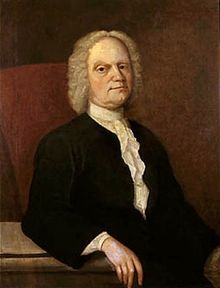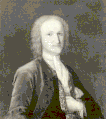Gustavus Hesselius
| Gustavus Hesselius | |
|---|---|
 Self portrait, ca 1740 | |
| Born | Gustaf Hesselius 1682 Folkärna, Dalarna, Sweden |
| Died | May 25, 1755 Philadelphia |
| Nationality | |
| Known for | Painting |
Gustavus Hesselius (1682 – May 25, 1755) was a Swedish born painter who emigrated to the New World in 1711. He was the father of painter John Hesselius and cousin of the religious leader Emanuel Swedenborg.[1]
Contents
1 Biography
2 Style
3 The Last Supper
4 Gallery
5 Other significant works
6 References
7 Sources
8 Further reading
9 External links
Biography
Hesselius left his home country of Sweden for Wilmington, Delaware in 1711. There he lived until 1717 when he moved to Philadelphia, Pennsylvania, where he lived until 1721. In 1721, he moved to Prince George's County, Maryland and became a portrait painter, though he had been trained in Sweden. That same year, he received the first recorded public art commission in the American colonies; he painted The Last Supper. He also painted a Crucifixion. Some time around 1735, Hesselius returned to Philadelphia where he spent the rest of his life and traveling.[1] He was listed as a member of the Gloria Dei (Old Swedes') Church in Philadelphia.
He also worked as an organ builder, having built an organ for the Moravian Church in Bethlehem, Pennsylvania in 1746. From about this time on, he focused on building organs with the assistance of John Clemm.[2] He referred painting commissions to his son John.[1]
J. Hall Pleasants has said that Hesselius became "America's earliest portrait painter of note." In 1994 he was named to the Prince George's County Hall of Fame.[3]
Style
While most of his portraits adhere to the formality typical for American portrait painting of his time, according to Michael J. Lewis, his portrait of Lappawinsoe, chief of the Lenape, was among the first to foreshadow "the sympathetic and unaffected realism" that would later develop in American portraiture. The painter was able to ignore the rigid conventions of colonial society because Lappawinsoe was a member of a First Nation.[4]
The Last Supper
The Last Supper by Gustavus Hesselius was the first recorded public art commission in the American colonies. Commissioned in October 1721, it is displayed on the choir gallery of St. Barnabas Church, Upper Marlboro, Maryland.[1][5][6] Before this, most painting in the new world had been portraits. The Last Supper was the first significant American painting to depict a scene.[5]
The painting which measures 35 inches by 117½ inches[6] was commissioned for an older church built in 1710, and remained there until the present structure was built in 1774.[7] It disappeared during the construction of the new Brick Church and did not surface again until it was discovered in a private collection in 1848[5] or 1914, when Charles Henry Hart identified it,[6] depending on which source one follows.
It was on loan by Rose Neel Warrington for a period at the Philadelphia Museum of Art and at the American Swedish Historical Museum[5] as well as the Exhibition of Early American Paintings at the Brooklyn Institute of Arts and Sciences in 1917 and the Wilmington Society of the Fine Arts.[6] The painting was willed once again to St. Barnabas upon Warrington's death.[5]
Gallery

Lappawinsoe, (1735).
Benjamin Fendall I
Eleanor Fendall

Mary Darnall Carroll
Other significant works
Lapowinsa, by Gustavus Hessulius, c. 1735. Oil on canvas, 33 × 25 in (83.8 × 63.5 cm). Philadelphia Museum of Art, Philadelphia.
Tishcohan, by Gustavus Hessulius, c. 1735. Oil on canvas, 33 × 25 in (83.8 × 63.5 cm). Philadelphia Museum of Art, Philadelphia.
Thomas Bordley, by Gustavus Hesselius, c. 1715. Oil on canvas. 27 × 22 41/64 in.(68.6 × 57.5 cm). Maryland Historical Society Accession: 1891-2-1[1]
Mrs. Charles Carroll, the "Settler"', by Gustavus Hesselius, c. 1717–1720. Oil on canvas. 30 7/64 × 25 13/64 in. (76.5 × 64.0 cm). Maryland Historical Society Accession: 1949-64-1[1]
Col. Leonard Hollyday, by Gustavus Hesselius, c. 1740. Oil on canvas. 27 55/64 × 23 7/64 in. (70.8 × 58.7 cm). Maryland Historical Society, Accession: 1960-88-1[1]
References
^ abcdefg "Maryland ArtSource - Artists - Gustavus Hesselius". The Baltimore Art Research & Outreach Consortium. Archived from the original on May 19, 2007. Retrieved 2008-02-09..mw-parser-output cite.citation{font-style:inherit}.mw-parser-output q{quotes:"""""""'""'"}.mw-parser-output code.cs1-code{color:inherit;background:inherit;border:inherit;padding:inherit}.mw-parser-output .cs1-lock-free a{background:url("//upload.wikimedia.org/wikipedia/commons/thumb/6/65/Lock-green.svg/9px-Lock-green.svg.png")no-repeat;background-position:right .1em center}.mw-parser-output .cs1-lock-limited a,.mw-parser-output .cs1-lock-registration a{background:url("//upload.wikimedia.org/wikipedia/commons/thumb/d/d6/Lock-gray-alt-2.svg/9px-Lock-gray-alt-2.svg.png")no-repeat;background-position:right .1em center}.mw-parser-output .cs1-lock-subscription a{background:url("//upload.wikimedia.org/wikipedia/commons/thumb/a/aa/Lock-red-alt-2.svg/9px-Lock-red-alt-2.svg.png")no-repeat;background-position:right .1em center}.mw-parser-output .cs1-subscription,.mw-parser-output .cs1-registration{color:#555}.mw-parser-output .cs1-subscription span,.mw-parser-output .cs1-registration span{border-bottom:1px dotted;cursor:help}.mw-parser-output .cs1-hidden-error{display:none;font-size:100%}.mw-parser-output .cs1-visible-error{font-size:100%}.mw-parser-output .cs1-subscription,.mw-parser-output .cs1-registration,.mw-parser-output .cs1-format{font-size:95%}.mw-parser-output .cs1-kern-left,.mw-parser-output .cs1-kern-wl-left{padding-left:0.2em}.mw-parser-output .cs1-kern-right,.mw-parser-output .cs1-kern-wl-right{padding-right:0.2em}
^ Baker 1992, p. 340.
^
"The Prince George's Hall of Fame". Prince George's County Historical Society. 2003. Retrieved 2017-10-27.
^ Lewis, Michael J. (2006). American art and architecture. London: Thames & Hudson. p. 28. ISBN 0-500-20391-1.
^ abcde Virta, Alan (1984). Prince George's County: A Pictorial History. Norfolk, Virginia: The Donning Company. pp. 67–69. ISBN 0-89865-812-8.
^ abcd Marceau, Henri (1931). "Bulletin of the Pennsylvania Museum, Vol. 26, No. 142, Part 1". Bulletin of the Pennsylvania Museum. Pennsylvania Museum of Art. 26 (142): 10–13. doi:10.2307/3794543. JSTOR 3794543.
^
"St. Barnabas Episcopal Church, Maryland Historical Trust, Historic Sites Survey # PG:79-59". Maryland State Archives. Archived from the original (web database) on 2007-09-05. Retrieved 2007-09-27.
.mw-parser-output .refbegin{font-size:90%;margin-bottom:0.5em}.mw-parser-output .refbegin-hanging-indents>ul{list-style-type:none;margin-left:0}.mw-parser-output .refbegin-hanging-indents>ul>li,.mw-parser-output .refbegin-hanging-indents>dl>dd{margin-left:0;padding-left:3.2em;text-indent:-3.2em;list-style:none}.mw-parser-output .refbegin-100{font-size:100%}
- Atwater Kent Museum, Philadelphia - Gustavius Hesselius
- Richard H. Saunders and Ellen G. Miles, American Colonial Portraits, 1700–1776, Washington, D.C.: National Portrait Gallery, Smithsonian Institution, 1987.
Sources
Baker, Theodore (1992). Baker's Biographical Dictionary. Schirmer Books. ISBN 978-0-02-872415-7.
Further reading
- Pleasants, J. Hall Two Hundred and Fifty Years of Painting in Maryland(Baltimore, Maryland: Baltimore Museum of Art. 1945)
- Lindsey, Jack L., Worldly Goods, The Arts of Early Pennsylvania, 1680–1758 (Philadelphia, PA: Philadelphia Museum of Art, 1999)
External links
"Hesselius Family Papers, 1780-1820s", The Frick Collection/Frick Art Reference Library Archives.



